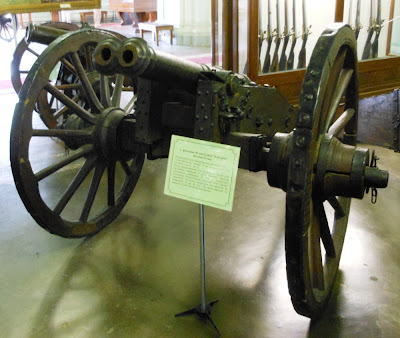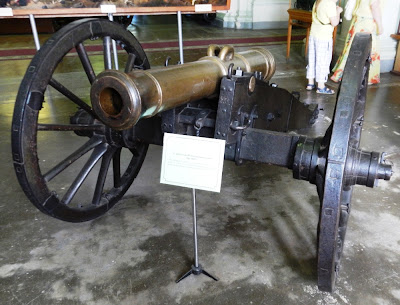In one of the large galleries the Artillery Museum has a considerable collection of cannons and mortars on display that show the development of artillery from earliest times up until the end of the Crimean War.
A trophy cannon (thought to have been cast in the Netherlands in the eighteenth century) that was captured by the Prussians at the end of the Napoleonic Wars and then brought to St Petersburg after World War II.
Another view of the trophy cannon.
An early Russian mortar and mortar shells.
An experimental Russian multi-barrelled volley gun.
A 44-barrelled volley mortar. The barrels were mounted on a large revolving platform that could be turned and locked into place. It fired several barrels at once, and then the revolving platform was unlocked, turned until the next bank of barrels was in position, and then locked prior to them being fired. It was designed by A K Nartov and built in the St. Petersburg Arsenal in 1754.
A 1-pounder, twin barrelled cannon (called 'Blizniata' or 'Twins'). It was cast in the St. Petersburg Arsenal in 1741.
A late seventeenth/early eighteenth century Russian light cannon.
A half-pounder cannon that was specially cast in the second half of the 17th century on the orders of Tsar Aleksei Mikhailovich. He gave the cannon to his son, Peter I, who learnt how to fire it as part of his military training. It was crewed by members of the Poteshny Regiment of boy-soldiers, a unit that had been raised so that Peter I could carry out field exercises with real troops.
An experimental Russian howitzer.
Another view of the experimental Russian howitzer showing its very unusual bore.
An early eighteenth century Russian howitzer.
A half-pood (18-pounder) long barrelled howitzer. It was cast in 1712.
Another view of the half-pood (18-pounder) long barrelled howitzer.
A typical late eighteenth/early nineteenth century Russian artillery limber.
Another view of the artillery limber.
A typical Russian field gun from the early nineteenth century.
Another view of the Russian light field gun.
The typical early nineteenth century Russian light field gun as seen from the left and front.
The typical early nineteenth century Russian light field gun as seen from the front.
A Russian filed gun as used during the Crimean War.
A Russian heavy gun as used during the Crimean War. Its limber can be seen to the right of the photograph..
A Russian fortress gun as used during the Crimean War.
A heavy Russian fortress gun as used during the Crimean War.































.jpeg)

























Bob
ReplyDeleteGreat photos once again. IIRC the odd howitzer is a Shuvalov (spelling?) used in the SYW. It only fired canister and the odd barrel was shaped to maximize the spread of the discharge.
Cheers
PD
Peter,
ReplyDeleteThanks for the information about the howitzer. There were several other artillery pieces on show with bores that were wide oblongs, and your explanation that they were so designed to ensure that canister spread in a particular way makes perfect sense.
All the best,
Bob
Bob
ReplyDeleteThe weapon was supposed to be a secret "wonder weapon" but like most was a squib. A quick google led to this description on Wikipedia, but I recall reading similar stuff in sources that haven't fallen off the back of a truck (most notable Duffy's "Russia's Military Way to the West"
http://en.wikipedia.org/wiki/Secret_howitzer
Cheers
PD
Peter Douglas,
ReplyDeleteSounds like a typical 'wonder' weapon; the theory makes sense but they don't work any better than existing weapons when they are built.
I may have some other photographs of cannons designed by Shuvalov. If I can find them I will write a blog entry about them.
All the best,
Bob
PS. Thanks for the link. It was very interesting.
Some great pictures there Bob, of some interesting designs. Many, with hindsight, turned out to be evolutionary dead-ends but fascinating all the same.
ReplyDeleteCheers,
Pete.
Pete,
ReplyDeleteThe museum does have some wonderfully quirky experimental cannons on show. I just wish that I had had time to photograph more of them!
All the best,
Bob